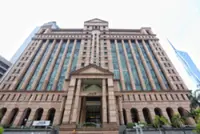Bumpy road: Toyota vehicles bound for shipment at the Port of Nagoya in Japan. According to some unofficial estimates, one unnamed automaker is losing US$1mil an hour due to US tariffs. — Bloomberg
Tokyo: Toyota Motor Corp is the biggest carmaker in the world –and also the auto industry’s biggest loser when it comes to projected losses from US President Donald Trump’s trade war.
Duties on imported cars and auto parts forced General Motors Co to slash its full-year profit guidance by as much as US$5bil, while Ford Motor Co is bracing for a US$1.5bil annual hit.
Toyota sees a US$1.2bil profit drop in just two months.
While the Japanese automaker didn’t provide a tally for all of this year, it did project operating income of 3.8 trillion yen or about US$26.1bil for its financial year ending March 2026 – far below the 4.7 trillion yen expected by analysts.
While Toyota has increased local production in the United States to more than half of sales in the country, it still relies on imports of key vehicle parts and models – to the tune of some 1.2 million cars a year.
The White House has noticed, with Trump calling out the Toyota City-based automaker by name during his contentious Liberation Day speech in the Rose Garden on April 2.
He complained about Toyota’s “one million foreign made automobiles” sold in the United States.
The huge tariff hit reflects the company’s decision to hold the line on sticker prices at US dealers and production volumes at its 11 American factories amid the start of bilateral trade negotiations between the United States and Japan.
Those talks started in February and it’s unclear when they will conclude with a deal.
“When it comes to tariffs, the details are still incredibly fluid,” Toyota’s chief executive officer, Koji Sato, said last week after releasing the latest financial results. “It’s difficult to take steps or measure the impact.”
Japan’s chief trade negotiator, Ryosei Akazawa, said on April 30 that one unnamed Japanese automaker is currently losing around US$1mil per hour from the tariffs, citing a calculation made by an unidentified corporate executive.
A Japanese government official last Friday declined to provide more specifics. But that rate of loss isn’t too far off the mark from the US$1.2bil hit Toyota is projecting based on 730 hours per month.
Representatives for Toyota also didn’t respond to a request for comment.
Akazawa has expressed hope that an agreement could be reached in June with the next round of negotiations taking place in late May.
Most imported vehicles became subject to a 25% US duty on April 3, while most auto parts become subject to that levy as of May 3.
There are some executive orders that prevent duties from doubling up, but considering the United States is the biggest market for Japan’s five largest carmakers, even a moderately increase in tariffs will have an outsized impact on their bottom lines.
The Trump administration reached its first trade deal on May 8 with Britain. But the United States had a US$11.9bil goods trade surplus with Britain last year, whereas it ran a US$68.5bil deficit with Japan.
That may make it more difficult to secure an agreement without significant concessions by one side.
“The hurdle is high for Japan to get auto tariffs lowered” on exports to the United States, said Hiroshi Namioka, chief strategist at T&D Asset Management Co. “At the same time, the auto industry is too important for Japan to simply go along with what the US wants.”
Some Japanese automakers have responded to the tough new trade environment by making changes to their global manufacturing footprints.
Nissan Motor Co halted US orders for sport utility vehicles built in Mexico while Honda Motor Co is shifting production of the hybrid version of its Civic from Japan to the United States.
Due to retaliatory tariffs against the United States, Mazda Motor Co is stopping exports to Canada of one model that’s manufactured at an Alabama factory that’s a joint venture with Toyota.
“We will maintain our current operations while continuing to focus on reducing fixed costs, all while keeping a close eye on the movements by US authorities, including customs duties,” a spokesperson for Toyota said in a statement.
Toyota has already invested heavily to build out its US operations – including spending US$13.9bil on a new battery plant in North Carolina.
But it also remains committed to maintaining its extensive domestic production base.
Chairman Akio Toyoda has repeatedly pledged to keep making at least three million vehicles a year in Japan.
Last year, the company built 3.1 million cars in its home country, about a third of its worldwide production total.
Globally, Toyota sold 10.8 million cars last year, with the United States accounting for a little less than a quarter of those.
While half were made locally and another 30% came from neighbouring Canada and Mexico, some 281,000 vehicles were imported from Japan.
That includes popular models such as the 4Runner mid-sized sport utility vehicle, Prius hybrid and several upscale Lexus vehicles.
The company’s best-sellers in the United States – the RAV4 hybrid crossover and Corolla compact sedan – are assembled at factories in Kentucky and Mississippi. But petrol-only RAV4s are imported from Canada and the plug-in hybrid comes from Japan. — Bloomberg





